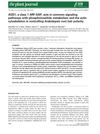Two-Ligand Priming Mechanism for Potentiated Phosphoinositide Synthesis Is an Evolutionarily Conserved Feature of Sec14-Like Phosphatidylinositol and Phosphatidylcholine Exchange Proteins
May 2016
in “
Molecular biology of the cell
”
TLDR A protein in plants needs to bind two lipids to help with root hair growth, and this process is similar across different plant species.
The study demonstrated that the two-ligand priming mechanism for potentiated phosphoinositide synthesis was evolutionarily conserved in Sec14-like phosphatidylinositol and phosphatidylcholine exchange proteins, including those in higher plants like Arabidopsis. This mechanism required both phosphatidylinositol (PtdIns) and phosphatidylcholine (PtdCho) binding to stimulate phosphoinositide synthesis, which was essential for processes such as polarized root hair growth. Mutant proteins with defects in either binding activity showed significant functional impairments, underscoring the necessity of both lipid-binding activities. The findings suggested that this mechanism played a crucial role in lipid signaling and membrane trafficking across different species, possibly due to convergent evolution or lateral gene transfer.
